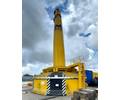BP in late August was in the final stages of permanently plugging the deepwater Gulf of Mexico Macondo exploration well, which spilled nearly 5 million barrels of oil between the 20 April blowout that destroyed the Deepwater Horizon rig and mid-July, when BP successfully installed a capping stack atop the failed blowout preventer.
Satisfied with the results of ambient pressure tests measuring the stability of the well’s annulus, national incident commander Thad Allen had authorized BP to replace the existing BOP and capping stack with a BOP taken from the backup relief well being drilled by the Development Driller II nearby. A relief well begun earlier by the Development Driller III was within 50ft of its intercept target with the Macondo well at 17,909ft measured depth. BP planned to have the new BOP installed before the company resumed drilling.
A ‘static kill’ performed 3 August successfully plugged the well’s inner casing. Extensive pressure tests in the weeks following suggested that the cementing operation may also have plugged any possible leaks between the reservoir and the annulus. Officials nevertheless opted to proceed with the bottom kill to ensure a solid well kill. Concerns that pressure inside the annulus during the bottom kill could damage the capping stack and original BOP configuration pushed the bottom kill back from its initial mid-August completion date.
On 2 August, government and industry scientists studying the well’s flow rate estimated that the gusher had spilled about 4.9 million barrels of oil over 87 days. Early on, the well poured an estimated 62,000b/d; by the time it was capped in mid-July, the rate was down to 53,000b/d due to reservoir depletion.
About one-third of the total amount of oil was captured at the wellhead or mitigated through burning, skimming or the use of dispersants. Another 25% evaporated or dissolved, federal officials said, and another 16% was ‘dispersed naturally into microscopic droplets’.
The National Oceanic & Atmospheric Administration said the remaining 26% appeared to be degrading quickly through natural processes. OE



